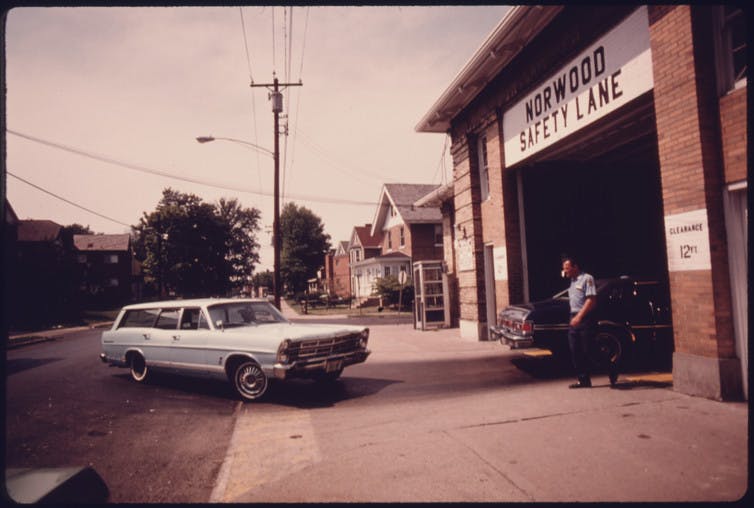In the midst of the Senate’s failure to agree on measures designed to tighten controls around the sales of firearms, a new idea is emerging.
Last week, U.S. Representative Jim Hines, a Democrat from Connecticut, appeared on “The Daily Show With Trevor Noah” and said, “we ought to probably test people and make sure there is as much licensing and regulation around a gun as there is around an automobile.”
He is not the first political figure to suggest this idea. Before the shooting in Orlando, President Obama proposed the same approach at a town hall meeting earlier this year:
…traffic fatalities have gone down drastically in my lifetime. And part of it is technology. And part of it is that the National Highway Safety Administration does research and they figure out seatbelts really work. And then we pass laws to make sure seatbelts are fastened.
Regulating guns like cars is an interesting idea. And, it wouldn’t require congressional approval.
Compared to the measures proposed in Congress, which amount to prohibitions against socially undesirable persons like terrorists and people who suffer from mental illness, a regulatory approach goes further by focusing on the technology itself. It would create a regulatory framework promoting responsible use of guns.
As sociologists who have studied the relationship between technologies and social control in a variety of settings, we believe the history of the automobile shows how such a strategy can make dangerous objects safer, while also preserving private property, individual liberty and personal responsibility.
How cars were made safe
The motor vehicle, like the firearm, is a quintessential American object. It expresses values of freedom, individuality and power. And like guns, automobiles were once a major threat to public health and safety.
Early vehicles regularly struck horses and pedestrians in the streets, gave birth to roving criminals like Bonnie and Clyde, and became common settings for sexual assaults. But through a combination of traffic codes, civil liability laws, insurance policies and administrative requirements, the automobile was eventually made manageable.

Subsequent eras of reform have addressed traffic safety in additional ways by targeting vehicle design (seatbelts and airbags), drunk drivers and distracted driving. As a result, the rate of traffic fatalities has decreased from more than 15 per 100 million vehicle miles traveled in the 1930s to just above 1 per 100 million today.
Regulating guns like cars
What would regulating guns like cars look like?
In some regards, we are already there. Operating a firearm, like operating a motor vehicle, requires a license in many jurisdictions. Certain types of criminal offenses – domestic violence in the case of firearms, drinking and driving in the case of automobiles – can result in a suspension or revocation of that license. These rules focus on the competency of users.
But, the regulation of cars goes beyond this by establishing a larger web of regulatory relationships around the technology itself.
As anyone who owns and operates a car knows, it must also be titled to establish ownership, registered to allow use of public roads and insured to protect owners and victims in the case of vehicle accidents. These requirements create an incentive for responsible conduct by drivers looking to avoid traffic tickets and insurance premium increases. It also helps finance a network of public and private entities, including police officers and insurance companies, to help keep track of cars.
Trips to the DMV notwithstanding, the regulatory burden of owning and operating a car has done little to diminish Americans’ love affair with the automobile.
Regulating guns like cars would thus require a new set of regulations that would reward the responsible purchase, possession and operation of guns, and build the regulatory framework to enforce it.
This is a more tried and true approach to managing dangerous technologies than the simplistic prohibitionist logic of simply keeping guns away from those we categorize as “the bad and the mad.”
But, guns aren’t cars
Some challenges to such an approach can easily be anticipated.
Legally speaking, gun rights supporters would point to the Second Amendment and argue that no mention of motorized vehicles is made in the country’s founding document. But the Fourth Amendment does pronounce “the right of people to be secure in their persons, houses, papers, and effects, against unreasonable searches and seizure,” a protection arguably violated by ordinary traffic stops. We as a society have still been able to craft a legal framework that balances this individual liberty with the public interest in vehicle safety.
There are practical differences, too. Cars are highly visible, which facilitates their control. Handguns are largely invisible, with their invisibility increasingly protected by law. This makes their regulation more difficult.

Cars on private property are not subject to state regulations. Yet, most gun deaths take place at home in the form of suicides. That means regulating guns like cars would likely not impact the greatest harm caused by firearms.
A way around gridlock?
Regulating guns like cars would provide additional safety against guns in the public spaces where the worst mass shootings have occurred – schools, the workplace, churches, dance halls and movie theaters.
Perhaps the best endorsement for regulating guns like cars is that it wouldn’t require congressional approval. States have the latitude to craft the requirements for owning and operating vehicles that suit them best. They could do the same with guns. Following the Supreme Court’s recent decision to not hear a challenge to Connecticut’s ban on assault weapons, states should be emboldened to try more innovative approaches on gun control.
Representative Hines and President Obama are thinking outside of the political box in addressing gun violence. Regulating guns like cars would be neither perfect nor easy. But as Congress continues to debate measures that largely look past the weapons themselves, it would be a welcome move in the national effort to prevent the next Columbine, Virginia Tech, Aurora, Newtown, Charleston, San Bernardino or Orlando.
![]()
This article was originally published on The Conversation. Read the original article.
